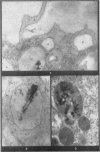Abstract
A series of experiments was undertaken to test the action of polyvinyl pyridine-N-oxide (P204) on the cytopathic effects of chrysotile asbestos dust in experimental animals. Organ culture studies were undertaken using pieces of guinea-pig lung, and in addition to this the lesions produced by the intrapleural injection of chrysotile were studied after treatment with varying doses of P204. The results from both series of experiments were unfortunately negative and P204 appeared unable to modify asbestos lesions in any way. These findings contrast sharply with the marked ability of P204 to protect tissues from the effects of silica dust. It is suggested that these differences are due to the fact that while silica is rapidly toxic to macrophages, asbestos is not and many healthy macrophages and giant cells can be found in asbestos lesions packed with dust several weeks after injection. The fibrous tissue that is eventually produced in response to asbestos dust is probably produced by a slower and more insidious process than that stimulated by silica, and this process is not modified by the presence of P204.
Full text
PDF









Images in this article
Selected References
These references are in PubMed. This may not be the complete list of references from this article.
- Allison A. C., Harington J. S., Birbeck M. An examination of the cytotoxic effects of silica on macrophages. J Exp Med. 1966 Aug 1;124(2):141–154. doi: 10.1084/jem.124.2.141. [DOI] [PMC free article] [PubMed] [Google Scholar]
- Davis J. M. The effects of chrysotile asbestos dust on lung macrophages maintained in organ culture. An electron-microscope study. Br J Exp Pathol. 1967 Aug;48(4):379–385. [PMC free article] [PubMed] [Google Scholar]
- HOLT P. F., YOUNG D. K. A dust-feed mechanism suitable for fibrous dust. Ann Occup Hyg. 1960 Nov;2:249–256. [PubMed] [Google Scholar]
- Heppleston A. G., Styles J. A. Activity of a macrophage factor in collagen formation by silica. Nature. 1967 Apr 29;214(5087):521–522. doi: 10.1038/214521a0. [DOI] [PubMed] [Google Scholar]
- KESSEL R. W., MONACO L., MARCHISIO M. A. THE SPECIFICITY OF THE CYTOTOXIC ACTION OF SILICA--A STUDY IN VITRO. Br J Exp Pathol. 1963 Aug;44:351–364. [PMC free article] [PubMed] [Google Scholar]
- Nash T., Allison A. C., Harington J. S. Physico-chemical properties of silica in relation to its toxicity. Nature. 1966 Apr 16;210(5033):259–261. doi: 10.1038/210259a0. [DOI] [PubMed] [Google Scholar]
- Parazzi E., Pernis B., Secchi G. C., Vigliani E. C. Studies on "in vitro" cytotoxicity of asbestos dusts. Med Lav. 1968 Oct;59(10):561–576. [PubMed] [Google Scholar]
- SCHIPKOETER H. W., DOLGNER R., BROCKHAUS A. EIN BEITRAG ZUR THERAPIE DER EXPERIMENTELLEN SILIKOSE. Dtsch Med Wochenschr. 1963 Sep 27;88:1895–1899. doi: 10.1055/s-0028-1112311. [DOI] [PubMed] [Google Scholar]
- Smith B. A., Davis J. M. The association of phagocytosed asbestos dust with lysosome enzymes. J Pathol. 1971 Nov;105(3):153–157. doi: 10.1002/path.1711050302. [DOI] [PubMed] [Google Scholar]





